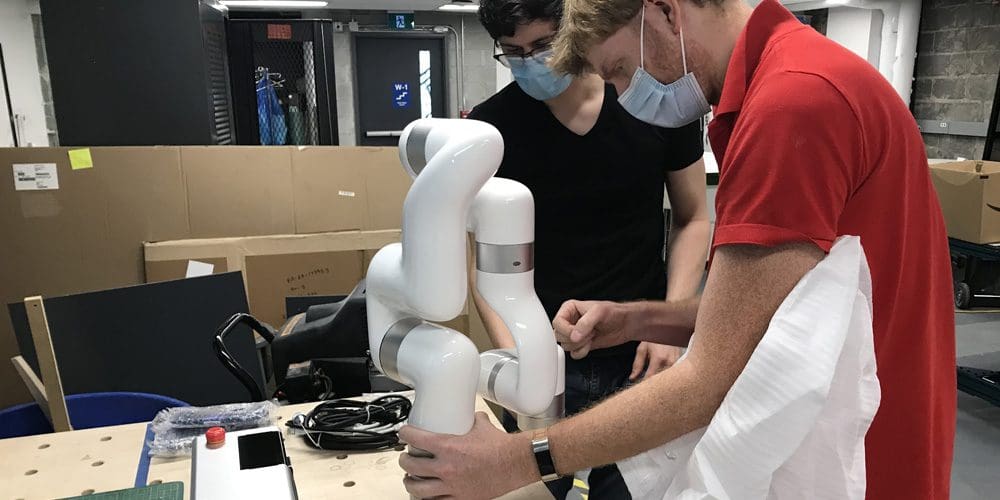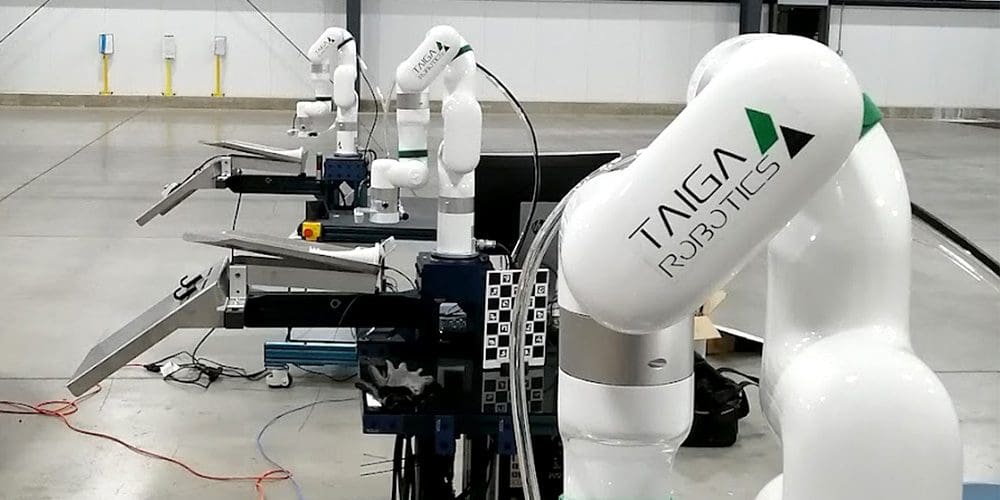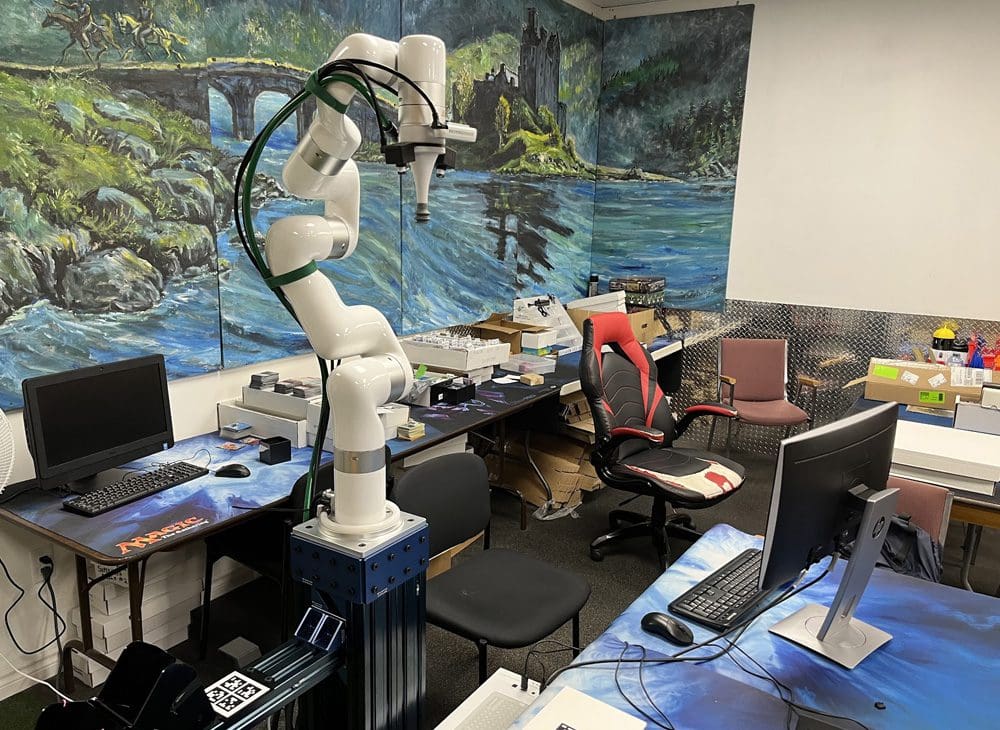Rent a robot: This Toronto startup helps small businesses reap the benefits of automation

Taiga Robotics programs its automatons to tackle everything from picking peppers to sorting through gaming cards.
Ilija Jovanovic and Bryan Stuurman — two of the co-founders of Taiga Robotics — program robots that they rent out to small businesses.
In early 2022, Kris Fekete, an entrepreneur from Newmarket, Ont., found himself with a problem he’d never anticipated: he had too many Magic cards and didn’t know what to do with them. Fekete is the co-owner of Enter the Battlefield, a store that specializes in collectable card games — the kind for which players strategically build their own decks, purchase by purchase, much as an army amasses an arsenal.
The store looks like a German beerhall, with rows of trestle tables where people congregate, custom decks in hand, to play Pokémon, Flesh and Blood, Yu-Gi-Oh and, of course, Magic: The Gathering, the original collectable game. The market for cards is like the market for used LPs. Customers sell items in exchange for cash or store credit. And the trade is brisk — too brisk, Fekete has learned, for his small staff to keep pace. In the back of the store, there’s a secondary space where Fekete keeps the backlog of unsorted Magic cards — an estimated 3 to 5 million — in shoe boxes stacked floor to ceiling.
But what to do with them? Magic cards, Fekete explains, are an esoteric currency. There are upwards of 20,000 unique cards in existence, and while most sell for mere pennies, some are worth tens of thousands of dollars. He could liquidate the collection to a wholesale distributor, but he’d be getting a fraction of its worth. He could hire an employee to sift through them, but human labour is so expensive it’s barely worth the cost. “This is the bane of my existence,” he says, gesturing to the boxes.
Then, last spring, his brother-in-law told him about a Toronto startup called Taiga Robotics, which had an unorthodox solution. Fekete was skeptical, until he called up the company and heard their pitch.
Automation for commitment-phobes
Taiga was founded in 2018 by three friends — Dmitri Ignakov, Ilija Jovanovic and Bryan Stuurman — who’d met as graduate students at Ryerson University (now the Toronto Metropolitan University). Ignakov’s mother, Tatiana Ignakova, was also a co-founder and is now chief financial officer. The company’s goal was to employ VR to build a better class of search-and-rescue (SaR) robots, like the ones that cleaned up after the Fukushima nuclear disaster. They won a major competition and several grants but struggled to find buyers. The SaR robotics market is dominated by large, bureaucratic institutions that aren’t likely to take a chance on a young company, even if it offers a superior product.
Perhaps, the partners reasoned, they were setting their sights too high. Was there a smaller, less-risk-averse market for industrial robots? A market whose buyers might be drawn to a scrappy startup like Taiga? Today, robots are revolutionizing the manufacturing and logistics sectors, but their efficiencies aren’t equally distributed. Large corporations can afford robotics; niche companies often can’t. “If you’re a small manufacturer and you want to deploy a robot,” says Ignakov, “you’re looking at $40,000 to $60,000 for the initial purchase and even more for programming.” But what if you don’t have that kind of money? Or what if you only want a robot on a short-term basis to handle a simple, time-limited task? This is the market that Taiga decided to target.
“We jokingly call our business model ‘robots with benefits,’” says Jovanovic. Instead of selling to you, Taiga will rent you a robot for a minimum of one year at a rate of U.S.$1,500 per month. They’ll program it to do whatever menial task you need it to do. And when the job is complete, they’ll redeploy it to perform some other service in your shop. “You get all the advantages of robotics,” says Jovanovic, “with none of the commitment.”

One of Taiga’s robots helped a greenhouse grower sort and pack bell peppers.
Learning to read the room
Although Taiga aims to make life easy for clients, the work is devilishly hard. In a large, hyper-mechanized plant — like a car factory, where everything happens the same way, day after day — an unsophisticated machine can easily perform repetitive motions in a predictable manner. But no small business is set up this way. In a bakery or mail-sorting facility or manufacturing workshop where people are coming and going and the environment constantly changes, a robot must read the room. It must put the pastries in the oven, but it mustn’t put the boss’s watch in the oven, even if the boss absentmindedly leaves it on the pastry tray.
One of Taiga’s early customers was a greenhouse grower who wanted a robot to sort and pack bell peppers, adding an equal number of red, green and yellow specimens to each box. To do this, a robot must see colour, it must navigate freely in space, it must distinguish between peppers and other objects, and it must know when to move and when to remain still. If a person sets a fresh tray of peppers nearby, the robot should get to work, but when the job’s done, it should call for help or look around for other peppers to sort, rather than pawing idly at the empty tray.
For Taiga’s pepper-sorting robot, the hardware components were simple: a base, a mechanical arm, a camera that sees colour and depth, and a gripper system comprising a suction cup and air intake — all of these bought online or assembled from basic parts. The tricky piece was the custom software. The team built an AI algorithm, which they trained in a virtual 3D environment modelled, loosely, on the pepper facility. After a week of virtual training, the robot was ready to practise in the actual greenhouse, making errors and learning from them.
The missteps could be surreal. Once, in a mailroom, a Taiga package-sorting robot mistook its own computer body for a piece of mail and tried to pick itself up. At the pepper facility, the robot underestimated its own strength and pulverized a pepper so aggressively the resulting splatter ruined Jovanovic’s shirt. Handling vegetables, as the robot soon learned, requires a certain finesse. “There’s no polite way to say this,” says Stuurman, “but in our line of work, you quickly realize that there’s a right and wrong way to, ahem, suck a pepper.” The exterior of a pepper is a topography of gentle planes, ideal for suction, and tight crevasses, which a suction device can’t easily grip. “If you suck a pepper in its, um, crack,” Stuurman continued, “you won’t be able to lift it.”

Enter the Battlefield, a trading card store in Newmarket, rented one of Taiga’s robots to help sort through its backlog of specialty cards.
“You’ve got to press the button”
After hearing Taiga’s pitch, Fekete, the co-owner of Enter the Battlefield, decided to give the company a chance. To see how things were going, I visited the store on a weekday last summer. The Taiga founders were hard at work in the backroom, training their robot — a modified version of the pepper picker. It resembled an anteater with a tapered, mechanical snout.
After about three weeks of programming, the device was able to read each Magic card and assess its worth, much as you’d assess the face value of a dollar bill. But on the day I visited, the team was trying to get the robot simply to pick up a card from a pile. Rather than gripping one card at a time, the robot was grabbing a stack of four of five. Jovanovic speculated that the air intake might be too strong. Stuurman argued that a laminate on the cards might be causing them to stick together. He proposed an experiment with electrical tape to test his hypothesis.
Eventually, the guys decided on a solution that would work in either case: They added a piece of plastic to the tip of the sucker, which would bend the card slightly, dislodging anything that might be stuck to the other side. “Our job, mostly, is to arrive on site, test the device, figure out what doesn’t match our assumptions, and find some way to fix the problem,” Stuurman explained.
By the time they’d fixed this particular problem, it was well past 5 p.m., and the after-work crowd had arrived for a round of Warhammer, a tabletop game involving miniature 3D battlefields. The presence of the robot kept distracting the players. A few strayed from the tables to check out the action. “You’ve got an audience, Dmitri,” said Stuurman to Ignakov, who was hunched over his laptop. “You’ve got to press the button.” Obliging him, Ignakov turned the robot on. The crowd watched as it dipped its snout and came up with a card — a single one this time — and then deposited its catch gracefully in a nearby sorting tray.
The last untapped market
Taiga’s work may seem trivial, but Fekete argues that the company has significant social value. Ultimately, its mission is one of democratization. Should robotics be available only to rich corporations as a cost-saving measure that enables them to get richer still? Or should small businesses have an opportunity to reap the benefits of automation? If you side with the latter opinion, then you can understand why a Magic card sorter — available cheaply, at a monthly rate — is a helpful product, even if the job is less ennobling than that of a search-and-rescue robot.
For robotics companies, local entrepreneurs like Fekete may constitute one of the largest untapped markets. “I bet you that, at every collectable card-game store on the planet,” Fekete says, “there’s a staff member who’s staring, with dread, at piles of cardboard.” A minor issue? Not if you’re the guy tasked with handling it. “This store is my world,” Fekete adds. “Every problem here is a big problem to me.”
Dmitri Ignakov, one of Taiga’s co-founders, is speaking at the second annual MaRS Supply AI Summit on November 21 on how robotics can help small businesses.
 Simon Lewsen
Simon Lewsen